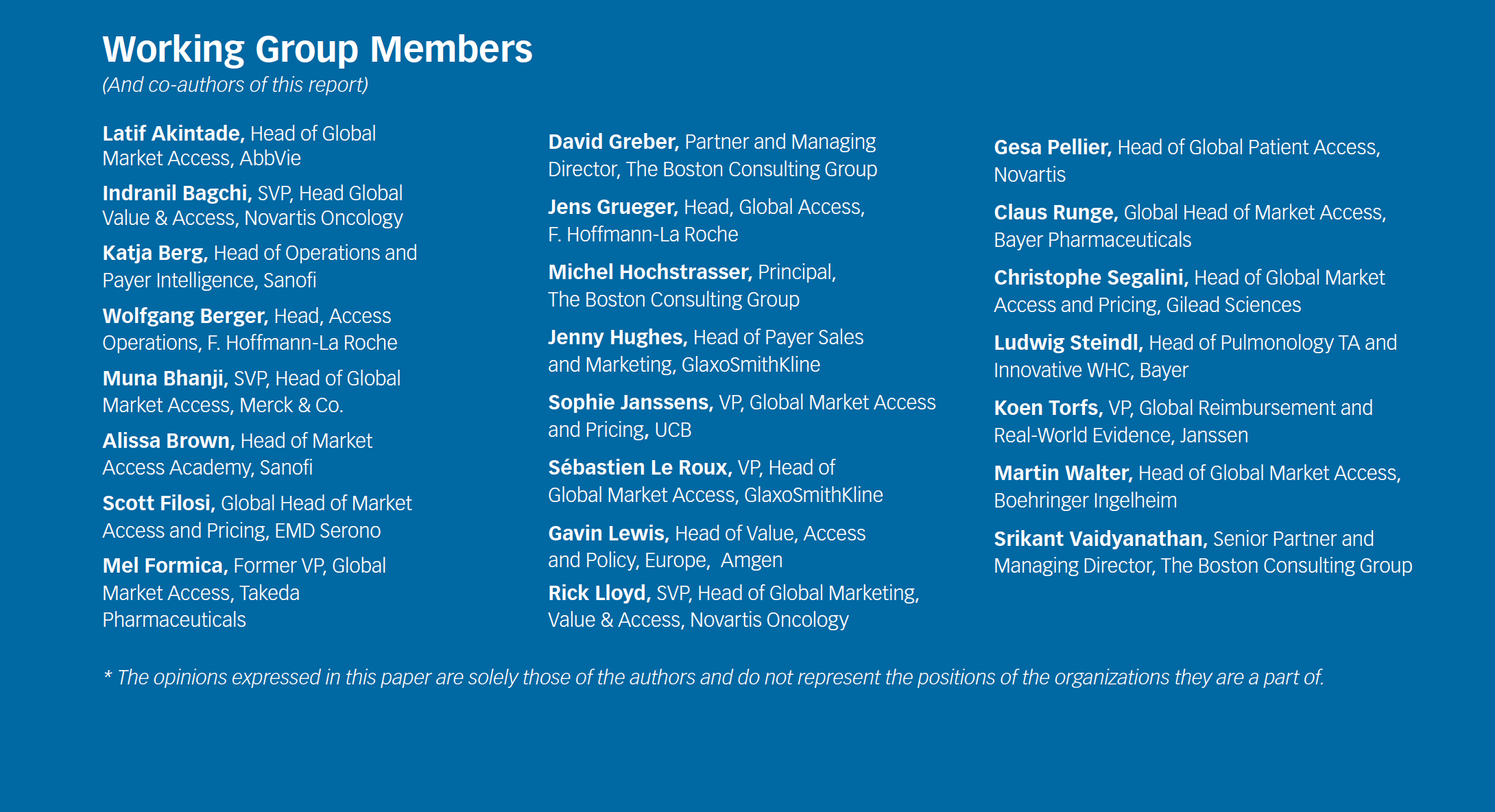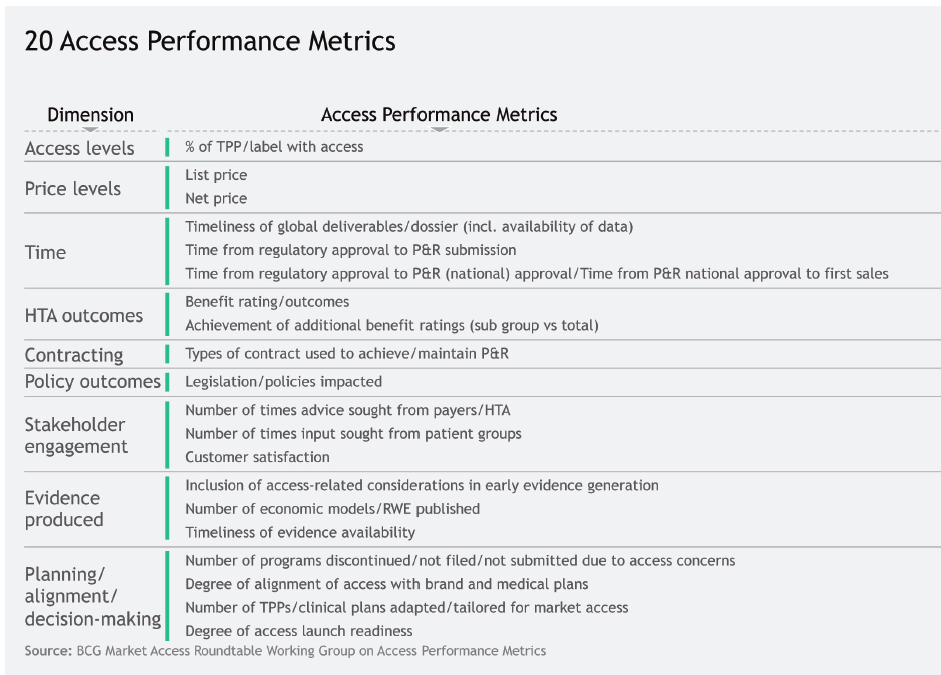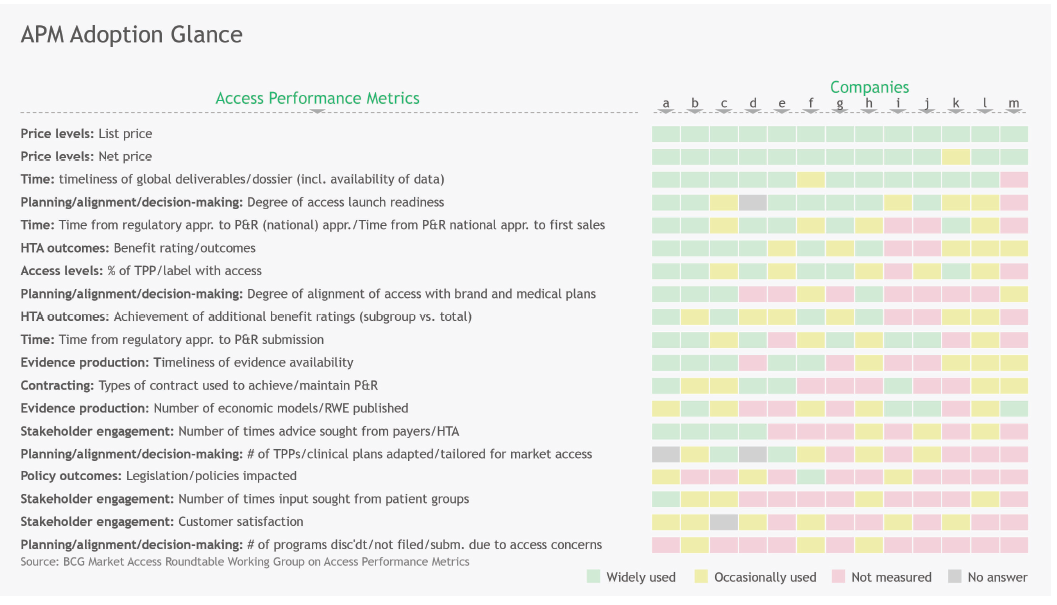Pinpointing Performance of Key Access Activities
Pharmaceutical Executive
While market access functions have evolved, the same can’t be said for measures used to gauge the contribution of these activities on overall business. To that end, an industry working group has developed a common framework focused on the most relevant access performance metrics (APMs).
While market access functions have evolved, the same can’t be said for measures used to gauge the contribution of these activities on overall business. To that end, an industry working group has developed a common framework focused on the most relevant access performance metrics (APMs)
Amid the ever-increasing healthcare funding challenge, securing patient access to medicines is becoming more and more complex. The access landscape continues to evolve shaped by three drivers:
- Increasing demand for healthcare, driven by aging societies and lifestyle choices that propagate chronic diseases, as well as improvements in diagnostic capabilities and the accessibility of treatments to broader sections of the population.
- Growing number of treatment options, as scientific innovation continues to provide healthcare systems with vastly improved treatment options and different treatment regimens (e.g., combinations, curative/gene therapy settings).
- Consequently, constraining healthcare are budgets that need to “buy more healthcare”-driven by both volume and cost increases, which lead payers to deploy further measures to optimize healthcare budgets.
Additionally, evolving regulatory pathways, as well as broader technology trends around data availability and analytics, are impacting the access landscape. Overall, achieving access is becoming an increasingly complex and cross-functional endeavor for pharmaceutical companies. And failing to secure patient access for a drug can have dramatic effects for patients and the manufacturers. A relentless focus on securing access to medicines is, therefore, becoming critical to the pharma business model. Access now concerns and impacts almost all levels of a pharma organization.
With access being increasingly core to the business, cross-functional involvement and prioritization becomes even more important. Consequently, the access function requires more sophistication in measuring the influence of access-related decisions. As the adage goes, “you can only manage what you measure,” hence, developing and using adequate access performance metrics (APMs) is key.
Convening power
Working Group Members; click to enlarge

The Boston Consulting Group (BCG) Market Access Roundtable is a forum that brings together senior market access leaders and serves as a platform for interactive discussion on industry-level topics.
The Roundtable members created a working group with the goal of developing a framework of the most relevant APMs. The framework, summarized in this paper, covers key access-related time points along the product lifecycle and thus enables relative comparisons over time.
Toward common and comprehensive APMs
While the access functions at all participant companies have begun to measure access performance, pharma companies think differently about what and how to measure. Also, there is no common language to describe different APMs, let alone common definitions. Some of the variance is driven by differences in companies’ portfolios, and, therefore, diverging access priorities and focus. The other driving force of the variation is the relative youth of the access function.
More “traditional” functions, for example, finance, regulatory, marketing, or manufacturing, have sets of long-established performance metrics that can be reviewed in any college textbook. As the access function has evolved in breadth and depth over the past years, there are no similarly well-established performance metrics that companies can follow. Most companies have developed their own metrics based on their needs at the time and what data was readily available. Thus, there are different metric definitions and use-cases across pharma organizations. Further, most of the roundtable participating companies acknowledged that the way they are currently measuring the performance of the access function could be improved.
The roundtable set out to see if a common framework could be created to serve the following two purposes:
1. Provide a more robust basis to measure access performance, and enable better decision-making upfront or in-flight course-correcting where necessary.
2. Evaluate and demonstrate the role and contribution of access activities and achievements to the overall business success.
Framework’s five principles
Toward the mentioned objectives, the Roundtable defined a framework that focuses on the most relevant APMs, and is guided by five design principles:
- Account for the interdependencies between different APMs.
- Cover key milestones along the product lifecycle.
- Enable relative/time-based comparisons.
- Encompass lagging and leading metrics.
- Cover the full scope of modern access functions.
1. Account for the interdependencies between different APMs. The three key access objectives-price, time to reimbursement, access level-are at the core of every access strategy. Collectively, they describe the strategic choices a company made during development and launch (and beyond). In an ideal world, one would be able to achieve a value-driven price, quick time to reimbursement, and broad access all at the same time. In reality, drug manufacturers need to make choices and tradeoffs between these three objectives. For example, to achieve a value-driven price point, longer negotiations may be required-thus impeding the objective of time to reimbursement. Similarly, when optimizing the price point, it is likely that payers limit reimbursement to a high-benefit subpopulation only, and rendering broad access impossible.
Hence, looking at APMs on these three strategic objectives in isolation is not helpful. Whether or not a certain time to reimbursement is fast can only be assessed in the context of the other two elements of the trinity of price, time to reimbursement, and access.
As a side note, the set of access parameters is not intended to form the basis for a benchmarking effort. Given the varying contexts of different products, and the divergent strategic decisions companies have taken, it is not meaningful to try to compare across products and companies. For example, comparing the price achievement or the time to reimbursement of two different products (or even companies) is meaningless without knowing the strategic objectives and tradeoffs taken. If the strategic objective was to optimize time to reimbursement, a company may have accepted a lower price point than the value of the product would have warranted. But as ex-post benchmarks cannot cover the strategic decisions taken many years before a price is achieved, a benchmark would hardly compare apples to apples.
2. Cover key milestones along product lifecycle. There are four key access time points along the product lifecycle that APMs need to cover: initiation of pivotal trial program, regulatory approval, (national) pricing and reimbursement approval, and peak sales-about five years post-pricing and reimbursement. Pharma companies make important access-relevant decisions long before launch, and APMs need to cover access-related decisions from the initiation of pivotal trials to give management a tool to track and course-correct before the impact is felt at launch. For example, evidence plans need to have incorporated access considerations already at the initiation of the pivotal trial program to avoid risking access evidence gaps.
3. Enable relative/time-based comparisons. It is important to note that some metrics (e.g., price, health technology assessment [HTA] outcome, access level) require “normalization” in order to be meaningful (i.e., by measuring actual versus planned). Covering APMs over time and including early access-related decision-points allows for relative comparisons and comparisons over time. Many APMs are meaningless when looking at their face value only. A point-in-time measurement of, for example, the “number of stakeholders involved” does not express if this number is high or low.
Similarly, a price achievement at launch provides richer insight if one can compare against planned price levels before launch. Any deviation from planned price levels then provides management an opportunity to dig deeper to understand “why,” and derive the required insights and actions. It is important to run such analysis at several points along the lifecycle as more becomes known about the drug.
4. Encompass lagging and leading metrics. We differentiate between leading and lagging metrics. While lagging metrics are important to assess outcomes (and derive learnings), most cannot be used to course-correct in-flight. Hence, it is critical to include a set of leading metrics that allow functional leaders and senior management to track in-flight progress, and take corrective action before the impact is felt.
5. Cover the full scope of modern access functions. While price is often the most visible, and most well-known, responsibility of the access function, it is by no means the only element that needs to be tracked. Just as the scope of the access function evolves, APMs need to go beyond pricing and reimbursement-focused topics and cover the full breadth of the access function. Thus, the framework covers the traditional access metrics of price (including contracting), access (including HTA outcomes), and time to reimbursement.
On top of those, it also covers APMs for aspects of access that have become more important recently: policy outcomes, stakeholder engagement, evidence generated, and cross-functional planning/alignment/decision-making. By covering all access-related aspects, it allows access leaders, as well as other functions and senior management, to focus on the right levers and derive meaningful insights.
Six additional APM dimensions
Based on these five design principles, the Roundtable defined an access performance metrics framework covering 20 APMs along four time points over the product lifecycle. In addition to the three key access metrics already discussed, the framework covers six other dimensions of APMs.
HTA outcomes: This APM is typically “owned” by HEOR (health economics and outcomes research) teams, and relevant for specific countries (e.g., Germany, France).
Contracting:Covering the types of contracts used shows the local capabilities to devise and negotiate innovative contracts, as well as giving insights on whether the full breadth of possibilities was explored to achieve favorable access conditions.
Policy outcomes:As health policy becomes more important, access leaders are required to track and measure the impact of policy work. Given the qualitative nature of the type of work that is being measured, this APM is less of a “hard” measure than, for example, price.
Stakeholder engagement: With the expanding scope of access, and the proliferation of stakeholders involved in access-related decisions, APMs around stakeholder management and engagement (e.g., via early parallel scientific advice) set the right incentives to access functions to engage with their stakeholders more systematically.
Evidence generated: Integrated evidence planning (i.e., the inclusion of access-related considerations when generating early regulatory evidence) is quickly and rightfully becoming the industry norm. To help the organization prevent evidence gaps at launch, tracking the access input into evidence generation is important. Other APMs, such as the number of HTA models and timeliness of evidence availability, also look at the organizational efficiency and effectiveness.
Planning/alignment/decision-making: The last set of APMs cover internal alignment and collaboration. Given the increasingly cross-functional nature of access, the alignment with other functions is an important leading metric to track. The more input the access function gave into TPP and clinical trial plans, and the higher the alignment between medical, commercial, and access plans, the higher the likelihood of achieving launch and access goals.
Figure 1 below lays out the 20 APMs across all dimensions, and Figure 2 maps the APMs along the key time points in more detail.
Figure 1. APMs across all dimensions.

Figure 2. APMs along the key time points.

Current APM adoption observations
While Roundtable companies agree on the need for more systematic tracking and measuring of APMs, only few apply all APMs across products in practice today. A survey on the adoption of APMs by Roundtable companies shows how the role of such metrics is evolving, but also demonstrates the large variance in metric definitions and usage to track performance and inform decisions. Based on the online survey of 14 Roundtable companies conducted in late 2017/early 2018, we make three overarching observations:
1. Most companies track three core APMs. These three APMs constitute some of the earliest and most well-established APMs.
- Negotiated price at list and at net price level as the fundamental metric to manage performance and track predictions (all companies).
- Timeliness (of global deliverables), which is widely seen as critical for launch success, as it drives resource allocation (~85% of companies). For some companies, it is seen as even more important than commercial deliverables.
- Access components of launch readiness. Relatively widely used to ensure focus and prioritization, but sometimes inconsistently applied across products (~70% of companies).
2. Tracking broader access factors versus a sole price focus is gaining traction. About half of Roundtable companies have moved to tracking product-specific access levels-a big change from only about five years ago, when access was rarely tracked systematically. The most advanced companies in this regard have now also included certain access achievements in their top-management personal goals. Overall, we note a move from pure focus on price achievement and management and launch preparation, to broader consideration of access levels, outcome metrics (e.g., benefit ratings), payer inputs, and evidence planning, among others.
3. There is a large variance in adoption and usage of APMs. While some companies systematically track 10-plus APMs, others track only a handful (see Figure 3 below).
Figure 3 shows the self-reported APM adoption of 14 Roundtable companies. The most commonly adopted APMs are shown on top, the least adopted APMs at the end. Each column represents one company. The chart outlines both the difference in adoption of different APMs (top to bottom) as well as the variance between companies (left to right).
Figure 3. Overview of APM adoption of participating 14 Roundtable companies.

Using the APM framework
The Roundtable is not suggesting that all companies use all APMs equally. Given each APM requires effort in generating, interpreting, and discussing the data, companies need to be selective in their use of APMs. Which APMs to track and what to use APMs for depends on several company-specific factors, including:
- Company portfolio in terms of type and number of products, disease-area focus, and breadth.
- Sophistication of the access function.
- Organizational setup.
- Data availability and/or effort required to generate certain APMs.
Given such company-specific considerations, there is no one-size-fits-all approach in tracking and using APMs. The framework provides a structured selection of the most relevant APMs. Companies, and especially access functions, need to define which of their objectives APMs can support, what they are trying to achieve and incentivize through an APM, and how they plan to use the metric. While APMs cover access themes, each metric does not necessarily need to be “owned” by the access function. Depending on what is measured and how the metric is used, responsibility for an APM may be better placed in a different function, or at regional/affiliate level.
Also, when using these measures, it is important to predefine “what good looks like.” Failing to do so can lead to unintended consequences. It is human nature to react to incentives-positive and negative-and an APM creates an incentive to optimize the outcomes of a certain APM. For example, an APM on “time to reimbursement” can in the worst case lead regional and local organizations to accept lower price points in order to achieve the given time-to-reimbursement target.
As it generally takes longer to negotiate value-driven prices, teams may be inclined to pursue and accept a lower price than the value of the product might warrant-or a reimbursement for only a subpopulation. Thus, teams may optimize for a certain APM, and lose sight of the more important goal to maximize access at a price that reflects the value of the product. Therefore, access leaders and senior management should not strive for 100% of markets to achieve the APM target of time to reimbursement. Eighty percent of the markets achieving the APM (and, consequently, 20% of markets not achieving reimbursement by the target time) is the better outcome; it means that the price level was set at the optimal level. If all markets achieved reimbursement in time, it is likely that local teams did not capture all the value in their pricing strategy and negotiations.
Looking ahead
Access functions need to continue to move from being purely a technical profession toward greater stakeholder and customer centricity. Today, access no longer focuses just on health economic modeling or price predictions, but instead addresses much broader, business-critical questions. Along with this broader focus, comes the need to better explain the value and impact access brings to the business. To better engage internal and external stakeholders, access leaders need tangible and simple access performance metrics that measure both outcome and progress along the way.
As the external access environment evolves, so will the use of APMs. The policy environment is likely to gain an even greater influence on access. Thus, pharmaceutical companies are also devoting greater focus on

tracking policy-related access activities through new APMs. In particular, APMs that could be used with external stakeholders to better explain efforts in achieving greater patient access, and create greater transparency to build trust will become more important.
With the APMs framework, the Roundtable aims to drive broader adoption of relevant APMs and ultimately shift beyond ex-post impact measurement, to supporting decision-making and changing course of action during development. Access will increasingly play a key role in driving effective investment toward innovative therapies that maximize benefits for all stakeholders. APMs can play an important role in elevating the profile of the access function through measuring access performance, and by providing a robust basis for communicating access considerations to different stakeholders.
Moving forward, the Roundtable hopes this framework helps provide clarity and greater consistency in how the role and contribution of access is being measured, managed, communicated, and conceived by other stakeholders. Given the cross-functional nature of market access, it is critical for all teams and departments in a pharma company to have a working knowledge of access, and understand how their decisions can impact patient access.

Trump: 'Major Tariff' on Pharmaceuticals Coming Soon
Published: April 9th 2025 | Updated: April 9th 2025“We’re going to tariff our pharmaceuticals, and once we do that, they are going to come rushing back into our country," President Donald J. Trump said during a Tuesday night dinner in Washington.